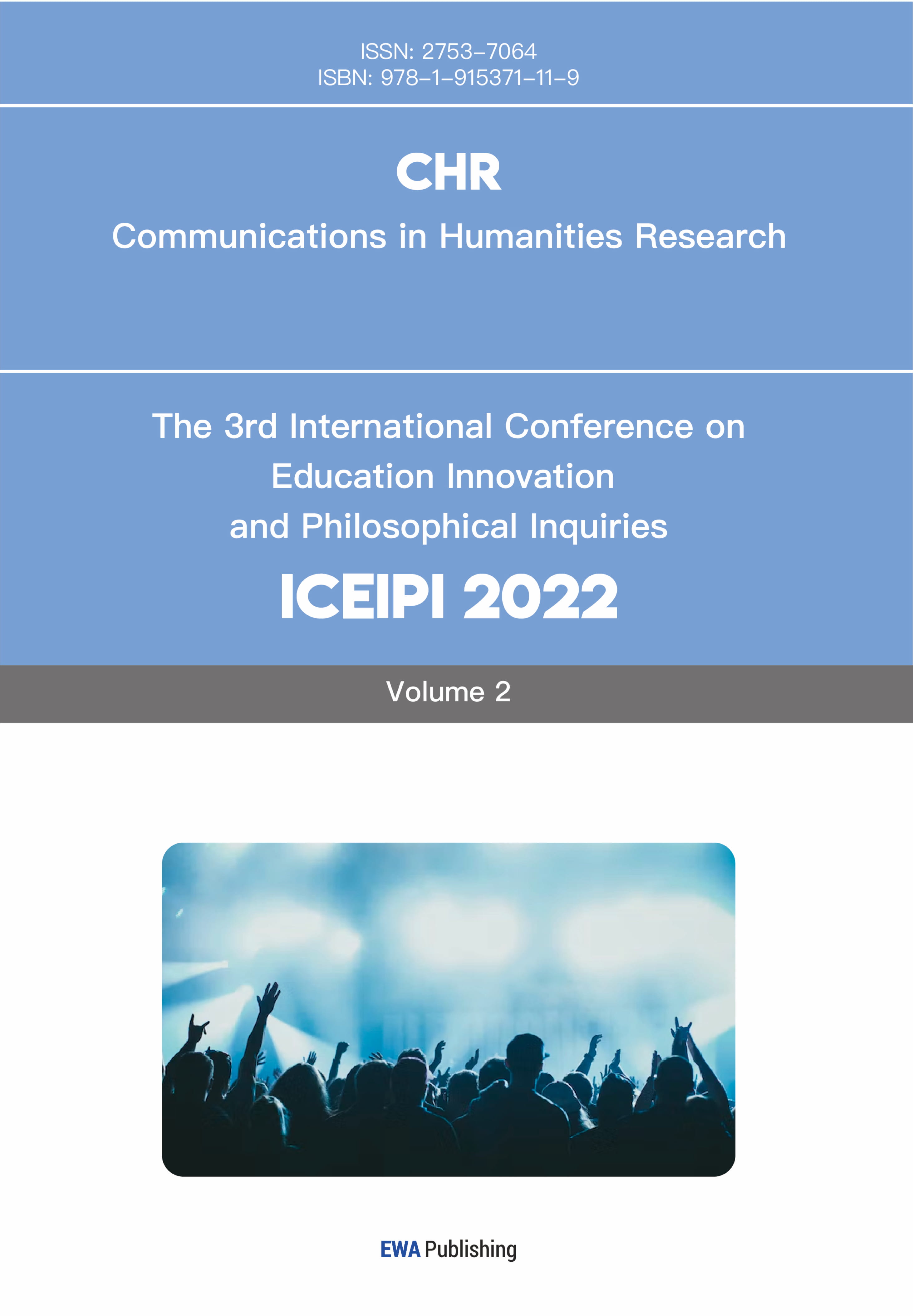References
[1]. Mileck, J., (1961) Names and the Creative Process: A Study of the Names in Hermann Hesse’s “Lauscher,” “Demian,” “Steppenwolf,” and “Glasperlenspiel”. Monatshefte, 167-180.
[2]. Webb, E., (1971) Hermine and the Problem of Harry’s Failure in Hesse’s “Steppenwolf”. Modern Studies, 17, 115-124.
[3]. Nana, S., (2013) On Female Inspirators in Hermann Hesse’s Middle Period of Creation in Nanjing University.
[4]. Xinyi, H., (2019) An analysis of gender narratives in Hermann Hesse’s novels. Master Pieces Review, 14, 49-52.
[5]. Peifen, Z., (2006) Hesse Study. 166-169.
[6]. Hesse, H., (2012) Der Steppenwolf in Penguin Group.
[7]. Michels, V., (2008) Hermann Hesse: Leben und Werk im Bild in Shanghai People's Publishing House. 214-217.
[8]. Cuixiang, H., (2021) Gender, Politics and Psychoanalysis: An Academic Dispute Between Critical Feminist and Postmodernism Feminist. World Philosophy, 6, 71-80.
[9]. Xiaolan, Z., (2011) An analysis on gaze theory in Nanjing University.
[10]. Joseph K.D., (1985) IMAGE, SYMBOL, AND ARCHETYPE: DEFINITIONS AND USES in Scriptorium Press.
[11]. Qian, X., (2012) “Anima” and “Animus” prototype theory put forward by Carl Jung in Guangxi Normal University.
[12]. Qiingyu, C., (2012) A Feminist Interpretation of Jungian Psychology in Nanjing Normal University.
[13]. Canrui, C., Heyong, S., (2011) The theory about self of Jung and Post-Jungian. Psychological Exploration,31:391-396.
[14]. Beauvoir, S., (2011) Le Deuxième Sexe I in Shanghai Translation Publishing House.
[15]. Tianyu, L., Binghuang, L., (2012) Modern Interpretation of Jung’s Androgynous Personality Theory. Journal of Hunan University of Science and Engineering, 31, 47-49.
[16]. Peterson, V. S., Runyan, A. S., (2021) Feminism in Jiangsu Phoenix Literature and Art Publishing.
[17]. Xiaohong, Y., Jianhua, L., (2010) Moral Thinking on C.G. Jung’s Analytical Psychotherapy Thought. Journal of Social Sciences of Hunan Normal University, 39,35-38.
[18]. Danylova, T.V., (2015) The way to the Self: the novel «Steppenwolf» through the lens of Jungian process of individuation. Антропологические измерения философских исследований, 7, 28-35.
Cite this article
Zhu,Q. (2023). The Feminist Criticism and Value of the Female Figure Hermina in Der Steppenwolf. Communications in Humanities Research,3,485-490.
Data availability
The datasets used and/or analyzed during the current study will be available from the authors upon reasonable request.
Disclaimer/Publisher's Note
The statements, opinions and data contained in all publications are solely those of the individual author(s) and contributor(s) and not of EWA Publishing and/or the editor(s). EWA Publishing and/or the editor(s) disclaim responsibility for any injury to people or property resulting from any ideas, methods, instructions or products referred to in the content.
About volume
Volume title: Proceedings of the International Conference on Interdisciplinary Humanities and Communication Studies (ICIHCS 2022), Part 1
© 2024 by the author(s). Licensee EWA Publishing, Oxford, UK. This article is an open access article distributed under the terms and
conditions of the Creative Commons Attribution (CC BY) license. Authors who
publish this series agree to the following terms:
1. Authors retain copyright and grant the series right of first publication with the work simultaneously licensed under a Creative Commons
Attribution License that allows others to share the work with an acknowledgment of the work's authorship and initial publication in this
series.
2. Authors are able to enter into separate, additional contractual arrangements for the non-exclusive distribution of the series's published
version of the work (e.g., post it to an institutional repository or publish it in a book), with an acknowledgment of its initial
publication in this series.
3. Authors are permitted and encouraged to post their work online (e.g., in institutional repositories or on their website) prior to and
during the submission process, as it can lead to productive exchanges, as well as earlier and greater citation of published work (See
Open access policy for details).
References
[1]. Mileck, J., (1961) Names and the Creative Process: A Study of the Names in Hermann Hesse’s “Lauscher,” “Demian,” “Steppenwolf,” and “Glasperlenspiel”. Monatshefte, 167-180.
[2]. Webb, E., (1971) Hermine and the Problem of Harry’s Failure in Hesse’s “Steppenwolf”. Modern Studies, 17, 115-124.
[3]. Nana, S., (2013) On Female Inspirators in Hermann Hesse’s Middle Period of Creation in Nanjing University.
[4]. Xinyi, H., (2019) An analysis of gender narratives in Hermann Hesse’s novels. Master Pieces Review, 14, 49-52.
[5]. Peifen, Z., (2006) Hesse Study. 166-169.
[6]. Hesse, H., (2012) Der Steppenwolf in Penguin Group.
[7]. Michels, V., (2008) Hermann Hesse: Leben und Werk im Bild in Shanghai People's Publishing House. 214-217.
[8]. Cuixiang, H., (2021) Gender, Politics and Psychoanalysis: An Academic Dispute Between Critical Feminist and Postmodernism Feminist. World Philosophy, 6, 71-80.
[9]. Xiaolan, Z., (2011) An analysis on gaze theory in Nanjing University.
[10]. Joseph K.D., (1985) IMAGE, SYMBOL, AND ARCHETYPE: DEFINITIONS AND USES in Scriptorium Press.
[11]. Qian, X., (2012) “Anima” and “Animus” prototype theory put forward by Carl Jung in Guangxi Normal University.
[12]. Qiingyu, C., (2012) A Feminist Interpretation of Jungian Psychology in Nanjing Normal University.
[13]. Canrui, C., Heyong, S., (2011) The theory about self of Jung and Post-Jungian. Psychological Exploration,31:391-396.
[14]. Beauvoir, S., (2011) Le Deuxième Sexe I in Shanghai Translation Publishing House.
[15]. Tianyu, L., Binghuang, L., (2012) Modern Interpretation of Jung’s Androgynous Personality Theory. Journal of Hunan University of Science and Engineering, 31, 47-49.
[16]. Peterson, V. S., Runyan, A. S., (2021) Feminism in Jiangsu Phoenix Literature and Art Publishing.
[17]. Xiaohong, Y., Jianhua, L., (2010) Moral Thinking on C.G. Jung’s Analytical Psychotherapy Thought. Journal of Social Sciences of Hunan Normal University, 39,35-38.
[18]. Danylova, T.V., (2015) The way to the Self: the novel «Steppenwolf» through the lens of Jungian process of individuation. Антропологические измерения философских исследований, 7, 28-35.









